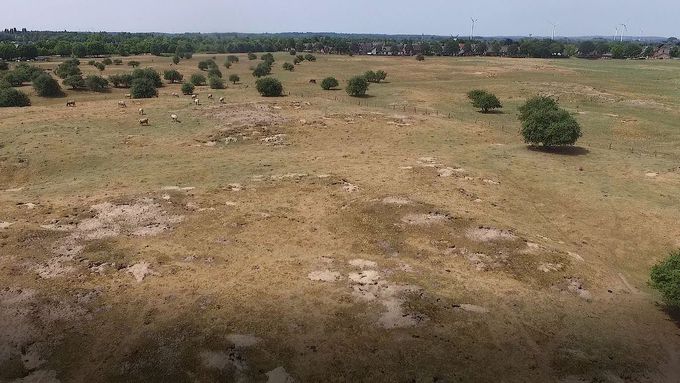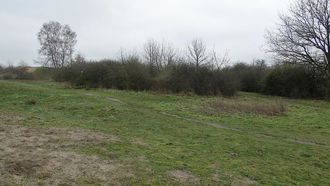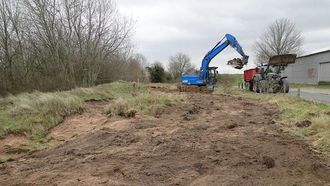Flat dunes in the southeast of the SAC ‘Wisseler Dünen’ © Wageningen Environmental Research, WUR
main content
Project of the month
#3/2018 ‘WISSELER DÜNEN’ NEXT TO KALKAR
Optimization of sandy xeric grasslands
The nature reserve ‘Wisseler Dünen’ is about 80 hectares wide, adjacent to the municipality of Wissel north of Kalkar, and includes the largest river sand dune area in North Rhine-Westphalia. Repeated floods of the Rhine led to constant deposition of sand on its banks in the Late Middle Ages. In summery low tide, large dune complexes were blown up at some distance by the winds from the dry-falling sand banks. The catastrophic sand drifts on the fertile haugh could not be cleared in the 14th century with the resources of that time. The dry-sandy terrain remained largely untapped and was used only as a sparse communal meadow for the grazing livestock of the citizens. Through centuries of grazing, there was no forestation. Today, the nature reserve is surrounded to the south, the east and the north by the lakes of Wissel, which have been created by gravel excavations in recent times.
The uniqueness of the dunes with their special flora was known early. In 1935, the ‘Wisseler Dünen’ were secured as the first nature reserve of the former district of Kleve – and one of the first in the Rhineland. At the beginning of the 1930s, the Reichsarbeitsdienst had planed a large part of the dunes on the outskirts of the village to create a glider airfield. As recently as the 1970s, two sports fields had been created in the midst of the nature reserve, which have since been removed. In August 1999, the ‘Wisseler Dünen’ were designated for the Europe-wide Natura 2000 network and in 2003 they were placed under protection as ‘large-area complex of river dunes which is nation-wide outstanding and holds exemplary and representative sandy xeric grasslands on inland dunes which belong to the largest ones in North Rhine-Westphalia’. The natural habitat of community interest is the habitat type ‘Inland dunes with open Corynephorus and Agrostis grasslands’ (2330), which needs to be preserved. As a species of common interest under the Habitats and the Birds Directives, the meadow pipit (Anthus pratensis) was mentioned at the time of establishment. Other important species include the gum succorry (Chondrilla juncea), which is threatened with extinction on the Lower Rhine, and the blue fescue (Festuca longifolia).
The meagre dry sands with extreme environmental conditions can only be colonized by specially adapted plants and plant communities. Typical colonizers on sand are e.g. whitish hair-grass (Corynephorus canescens), shepherd’s cress (Teesdalia nudicaulis), sheep’s bit (Jasione montana) as well as lichens and mosses. They form low-growing sandy xeric grasslands that cover the north and east of the nature reserve extensively. The central levelled area is characterized by drought-affected, very species-rich lean pastures with e.g. field eryngo (Eryngium campestre), lady’s bedstraw (Galium verum), and cypress spurge (Euphorbia cyparissias). Thorn scrub from distinctive whitethorn shrubs, wild roses, blackthorn and buckthorn still bear witness to the historic use as pasture.
The characteristic sand plants are undemanding in terms of water and nutrient supply, but tolerate neither shading nor humus enrichment by fallen leaves or dying off carpets of grass. The characteristic fauna of sandy xeric grasslands, such as sand bees and sand beetles, are also dependent on warm, dry locations which are exposed to the sun all day. Trees and shrubs or the dispersal of woody plants therefore have a negative effect on the sun-loving communities of the river sand dunes.
Since the ‘Wisseler Dünen’ in places have been experiencing a slow dispersal of shrubbery over the past 20 years, complexes of shrubbery on two selected sub-areas were completely cleared in February 2018 as part of the Integrated LIFE Project ‘Atlantic Region DE’ in order to stop the increasing encroachment of the valuable sand grassland. Overall, only a few percent of the thorn bushes in the reserve were affected. In three other places, the vegetation cover was stripped to create vegetation-free pioneer sites, while preserving the uneven dune relief and the habitat of rare plants such as gum succorry (Chondrilla juncea), field sagewort (Artemisia campestris) or marram grass (Ammophila arenaria). The stripped sods were removed and partly piled up to ramparts as secondary habitats at suitable places on the edge of the nature reserve.
The ‘Wisseler Dünen’ are under the control and supervision of the Lower Nature Conservation Authority of the District of Kleve and the Nature Conservation Centre in the District of Kleve, which also carried out the ecological construction supervision during the implementation of this action.
additional information
Further Links
- Special Area of Conservation ‘Wisseler Dünen’ – State Agency for Nature, Environment and Consumer Protection (LANUV NRW)(in German) (external link opens in a new window)
- Nature Reserve ‘Wisseler Dünen’ – State Agency for Nature, Environment and Consumer Protection (LANUV NRW) (external link opens in a new window)
- Places of excursions in the area – Experiencing Nature in NRW (in German) (external link opens in a new window)
- Nature Conservation Centre in the District of Kleve (in German) (external link opens in a new window)






